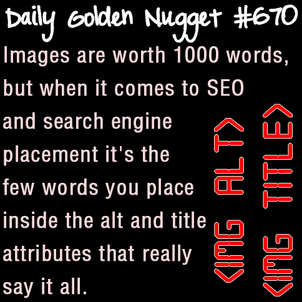 Here's a cool SEO technique for you, with regard to the images you use on your website, and how you use them for linking. This Daily Nugget will be good for those of you that manage your own SEO efforts on your website. I'll be explaining a little about HTML tags, so if you're not interested in playing the HTML code or SEO then you might just want to skip it.
Here's a cool SEO technique for you, with regard to the images you use on your website, and how you use them for linking. This Daily Nugget will be good for those of you that manage your own SEO efforts on your website. I'll be explaining a little about HTML tags, so if you're not interested in playing the HTML code or SEO then you might just want to skip it.The basic HTML code for any image is this:
<img src="image-name" alt="description" title="description" class="css-reference" />
The image-name will refer to the directory location and the actual image name. The class is the style sheet reference that controls the size, placement, and effects applied to the image.
Jewelry SEO professionals will have different points of view about the "alt" and "title" attributes I'm showing, for me, I've watched their importance increase during the past 12 months.
Most SEO professionals will not even mention the "title" attribute, but in my reality I find that alt/title have the biggest impact when they are both included, and both have the same information.
The alt attribute will cause a popup bubble to appear when you hover your mouse over an image viewed through Internet Explorer, but in Firefox and Chrome that popup bubble only appears if you use the title attribute. These popup bubbles add extra usability to your website and shouldn't be ignored.
I've found that the alt/title attributes carry three other forms of SEO weight that I explain below.
1. Link building
You might think that hyperlinking an image doesn't have the same link building power as linking text. The words you use in the hyperlink (called the anchor text) are passed to the search engines and use to rank your website. But linking an image won't pass the same anchor text value... unless you use the alt and title attributes. When linking an image the search engines will use the description of the image shown in the alt and title attribute as your anchor text.
2. On page keyword content reinforcement
Google looks for well written and high quality content on all your web pages. Adding the alt and title information to your images is an extra step that most people will not bother with. But I've found that taking the extra time to include a brief description of the image will help the ranking of your page. However, the description needs to reinforce other content you've mentioned on the page.
Let's say you are writing a blog post about a sapphire and diamond ring. If the accompanying image is of a model wearing that ring you could use the alt/title attributes of "woman wearing a sapphire and diamond ring." The alt/title reinforces the content. On the other hand if you simply said "sapphire and diamond ring" you might actually be penalized for keyword stuffing since you didn't add any extra value to the blog.
3. Image search placement
Carrying forward from number 2 above, that photo of the model wearing the ring will be absorbed into Google's image search. Google doesn't have eyes and it can't automatically "look" at an image and know what's inside. Normally Google will use the words on the page to guess what's in the image. Google also tried to figure things out based on the image name.
However, if you take the time to specify the alt/title attributes then Google will assume you are providing accurate information and it will safe your image accordingly. Your model photo could appear higher in the ranking the next time someone searches for a sapphire and diamond ring.
Images are great to your website; just make sure you use them correctly.









This tips are only for photos, or applies to links too?
Thank you!
Costi
mr.john.gm@gmail.com
www.craiovacenter.com/
05/01/2013 at 01:56:52